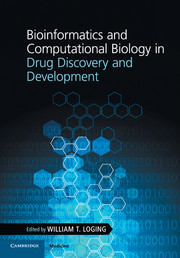Book contents
- Frontmatter
- Contents
- List of contributors
- Foreword: The future of drug discovery and healthcare
- Acknowledgments
- 1 The art and science of the drug discovery pipeline
- 2 Computational approaches to drug target identification
- 3 Understanding human disease knowledge through text mining
- 4 Integrating translational biomarkers into drug development
- 5 Computational phenotypic assessment of small molecules in drug discovery
- 6 Data visualization and the DDP process
- 7 Information visualization – important IT considerations
- 8 Example of computational biology at the new drug application (NDA) and regulatory approval stages
- 9 Clinical trial failures and drug repositioning
- Appendix I Additional knowledge-based analysis approaches
- Appendix II Open source tools and public data sources
- Index
- Plate section
- References
5 - Computational phenotypic assessment of small molecules in drug discovery
Published online by Cambridge University Press: 05 February 2016
- Frontmatter
- Contents
- List of contributors
- Foreword: The future of drug discovery and healthcare
- Acknowledgments
- 1 The art and science of the drug discovery pipeline
- 2 Computational approaches to drug target identification
- 3 Understanding human disease knowledge through text mining
- 4 Integrating translational biomarkers into drug development
- 5 Computational phenotypic assessment of small molecules in drug discovery
- 6 Data visualization and the DDP process
- 7 Information visualization – important IT considerations
- 8 Example of computational biology at the new drug application (NDA) and regulatory approval stages
- 9 Clinical trial failures and drug repositioning
- Appendix I Additional knowledge-based analysis approaches
- Appendix II Open source tools and public data sources
- Index
- Plate section
- References
Summary
The need for computational methods to characterize a new therapeutic compound's potential secondary pharmacology early in the drug development process is becoming increasingly important. The United States Food and Drug Administration (FDA) acceptance rate of new chemical entities (NCE) used in the treatment of human diseases has been unchanged over the past 60 years despite dramatically increasing investment in the past two decades (Munos, 2009). Multiple factors have contributed to this decrease in NCE approvals per unit investment including increased FDA standards, therapeutic approaches addressing more complex diseases, as well as issues with patient pharmacogenomic diversity.
As more small molecules are designed using combinatorial libraries and computational/structural biology methods, new and disparate forms of chemical matter are being produced for NCE consideration. These novel compounds do not have a history of associated side-effect profiles that established chemical matter have (e.g., penicillin analog). A retrospective analysis shows that nearly 30% of all new NCE failures in the year 2000 were attributed to problems with clinical toxicology, far more than any other single reason (DataMonitor, pharmaceutical report). From 2008 to 2010 there were 108 reported Phase II failures; of those reporting reasons for failure, 19% were reported due to clinical or preclinical safety issues (Arrowsmith, 2011a). At later stages in the development pipeline, combined successes in Phase III and submission have fallen to approximately 50%, with 83 failures between 2007 and 2010. Twenty-one percent of the failures across all therapeutic areas are due to safety issues (Arrowsmith, 2011b). Accordingly, while some progress has been made, it is critical that compound safety issues be addressed as early in the discovery pipeline as possible to reduce costly late-stage attrition.
The basic premise of drug toxicology is simple, but is complicated by the sheer size and complexity of the human proteome (Waring et al., 2015). Compounds, or their metabolites, that interact with the desired target protein can also bind to and alter the activity of other “off-target” proteins. Many times, these proteins can have their activity altered without significantly affecting normal human physiology. However, a protein's altered activity can lead to a change in a metabolic or signaling pathway critical to normal physiological function and hence to toxicological effects. Thus, identification of these “off-target” proteins and understanding the role they play in the human body is important.
Information
- Type
- Chapter
- Information
- Publisher: Cambridge University PressPrint publication year: 2016
